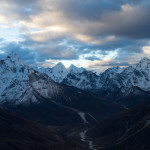Mexico Expedition
Just last year, as many of you already know, I lost my sight in the Middle East as I served in the United States Army. At that point in my life, it was my dream to be a part of the famed Green Berets or the Army’s Special Forces. I looked forward to the challenges of the future and I thought I knew what they would be. But, when you serve in a dangerous place, you can never lose your concentration or take your mind off of what you are doing, not for a minute or even a second. You never know what may be lurking around the corner, as was the case for me on May 13, 2008.
Now, a year and a half after the blast, I am doing very well. Nevertheless, the challenges I expected before my injuries have been of a very different nature, and it has been a long road. In the first place, I literally fought for my survival during the first couple of weeks at Walter Reed Army Medical Center. Then there were white cane and other mental and emotional frustrations at the Central Blind Rehabilitation Center at Hines.
All the while, I received tremendous amounts of support from family, friends, and organizations. Those who don’t already know me must know that I love life and there is no better way to live life than to experience what the world has to offer.
I have been able to do so many things during the past year, both because I want to and because of great people. My recent trip is only the latest example.
On Friday, November 6, I left Chicago for Mexico City, but I was certainly not alone. There were many other individuals from different parts of the world making the same journey. We gathered at the Mexico City International Airport to begin an expedition that would eventually lead us to the summit of the third tallest volcano in Mexico.
Global Explorers was the organization that lead the way and directed the program, spearheaded by the famous blind climber Erik Weihenmayer and several amazing staff members who have made many trips possible for young high school and university students. Erik personally invited me along for the adventure. I can’t thank enough, both him and everyone else involved, for providing the experience.
This was something that had never been done in Mexico. There were two parties of blind individuals, one from the U.S. and one from Mexico. The group included ten blind and visually impaired individuals from all walks of life, but there were many more that assisted us. If I am not mistaken, the count totaled more than 30.
Before we climbed, there was some immersion training that occurred. This took place in Amecameca, located about 90 minutes by car from Mexico City. We were shuttled out to a hotel named Hacienda Panoaya. Here we met the rest of the team to climb Iztaccíhuatl.
The Sierra Nevada is the region’s most important mountain range. The average altitude of the range is 4,000 meters above sea level. It ends with the Popocatépetl and Iztaccíhuatl volcanoes. Popocatépetl and Iztaccíhuatl are the second and third highest mountains in Mexico with an altitude of 5,452 and 5,284 meters, respectively. Amecameca is next to the volcanoes, located 2,419 meters above sea level. All of the rivers, streams, and springs result from the constant glacier melt in the Sierra Nevadas. Word is that Mexican ancestors worshipped the mountains, especially the Popocatépetl and Iztaccíhuatl Peaks, which were considered gods.
To give you an idea of its size, Iztaccíhuatl is taller than any mountain in the lower 48 states.
At the hotel, I met some great people: Michelle, Eric, Terry, and Eliza. These individuals made up our team. Although they were younger than I, they were all very mature and intelligent. After introductions, we set off to learn about the surrounding area. One of the main projects was to help paint a school and plant trees in a town outside Amecameca. The townspeople gathered to help paint. They also prepared a wonderful traditional Mexican lunch for us.
Two days later, on November 8, we were ready to go to base camp, which was near the bottom of the volcano. A van transported us to camp, taking about an hour and a half to get there from Amecameca.
The next morning, November 9, we climbed 75 percent of the way to “high camp” in order to acclimate ourselves. We got a true taste of the terrain that day. We felt the frozen mud beneath us right away. This gave us great traction to hike up the steep slopes. Here and there the terrain would become more sandy and rocky.
Navigating through large and small gauntlets, we protected ourselves by using our trekking poles. When we hit broken up rock and sand, I knew we were in for a workout. Trying to keep our balance and footing on the steep slopes was always tricky.
After climbing along steep ridges and boulders, we finally made it to our turnaround point. Another group traveled ahead for another 30 minutes but then turned around and headed back down the volcano toward base camp.
The next day, November 10, we climbed the rest of the way to high camp, where we stayed until the following morning so we could make our attempt on the summit. This day was memorable because of the increased communication among the guides and the blind. The weather was superb with no rain or wind to hinder us. We were truly blessed with good conditions.
Again we navigated the route we had already blazed. When we reached the turnaround point we had used the day before, we kept on climbing, this time to our goal of high camp. We ditched the trekking poles in climbing the more “technical” areas. This was not easy for me with my bad arm. Those familiar with my situation know that I have poor circulation and dexterity in my left arm due to my injuries in Iraq. It was a long day of hiking and climbing but we indeed made it to high camp.
The porters had set up camp and all we had to do was move into our tents. The night was filled with a combination of chitchat and snoring. Some slept great while others didn’t catch a wink. The fact that I heard both chitchat and snoring is evidence that I did not sleep well. Although many complained of altitude sickness, I did not have the symptoms they had, which were nausea, stomach pain, and headache. I believe I slept poorly mostly because my feet were so cold.
“Summit Day” was Veterans Day, November 11.
Everyone awoke to a chilly morning. My hands and feet were even colder after I left the tent. Because the air is thinner at a high altitude, there is less oxygen in the body, making it more difficult to breathe and do strenuous activities. I knew this before but now I was experiencing it. I also got hit with the fact that a lack of oxygen also makes one’s limbs colder.
I knew that the best thing to do was to get moving but, at the same time, I thought of going no further and making high camp my personal summit. Erik and Jeff talked me out of it. The reason I thought of stopping was that I couldn’t feel my left arm.
I did my best to hold onto the trekking pole and climb with the rest of the group. Slowly but surely the sun rose and it became warmer. We reached an area where our lead guide, Hector, set up ropes to help us climb the steep rock face.
In the distance I could hear faint shouts and screams. Some of the teams had made it to the top already! The radios carried by some would crackle, and I could hear crying and the sharing of the experience of being at the summit. It was so close now for me. There was no turning back.
My own guide, Alfredo, then led me to the top. I stood there with everyone else as the sun rose out of the clouds. It was truly an amazing daybreak on Veterans Day.
Thank you for taking the time to learn of my great experience. I hope everyone will reach for their dreams and goals on every scale and at every level, as we did on this marvelous trip. Live your life to the fullest and never give up!
[ngg_images gallery_ids=”6″ display_type=”photocrati-nextgen_basic_thumbnails”]
[line]
Special Thanks to Global Explorers / No Barriers for making this trip possible.




